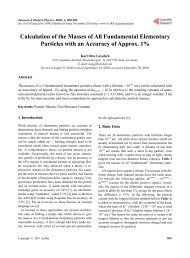Proteins: Fundamental Chemical Properties
Proteins: Fundamental Chemical Properties
Proteins: Fundamental Chemical Properties
Create successful ePaper yourself
Turn your PDF publications into a flip-book with our unique Google optimized e-Paper software.
<strong>Proteins</strong>: <strong>Fundamental</strong><br />
<strong>Chemical</strong> <strong>Properties</strong><br />
Alain J Cozzone, Institute of Biology and Chemistry of <strong>Proteins</strong>, CNRS, Lyon, France<br />
<strong>Proteins</strong> are important biological polymers formed from building blocks called amino<br />
acids. The three-dimensional structure and biological activity of proteins depend on the<br />
physicochemical properties of their constituent amino acids.<br />
Introduction<br />
<strong>Proteins</strong> are macromolecules found in all biological<br />
systems, from lower prokaryotes to higher eukaryotes.<br />
They occupy a prominent position in living cells, both<br />
quantitatively and qualitatively, which accounts for the<br />
origin of their name derived from the Greek word proˆtos,<br />
meaning ‘first rank of importance’.<br />
Quantitatively, proteins are the most abundant class of<br />
biomolecules since they represent over 50% of the dry<br />
weight of cells, far more than other important biopolymers<br />
such as nucleic acids, polysaccharides or lipid assemblies.<br />
Each organism contains a large variety of specific proteins,<br />
according to the number of the corresponding genes<br />
present in chromosomes. This number varies from a few<br />
hundreds in certain bacterial species to several thousands<br />
in animals and man.<br />
Qualitatively, proteins are involved in virtually all<br />
biological processes. Thus, most chemical reactions<br />
occurring in life forms are catalysed by specific proteins<br />
called enzymes that are able to increase reaction rates by<br />
several orders of magnitude. <strong>Proteins</strong> can also transport<br />
and store a wide array of ions and small molecules as well as<br />
electrons. They possess hormonal activity and, in the form<br />
of antibodies which distinguish between self and nonself,<br />
they defend organisms against intruders. They participate<br />
in the reception and transmission of signals and stimuli at<br />
both intracellular and intercellular levels. They play crucial<br />
roles in the regulation of the expression of genetic<br />
information, at either transcription or translation, in<br />
connection with the control of growth and differentiation<br />
of cells. They are also necessary for providing the<br />
mechanical support and filamentous architecture within<br />
and between cells, and consequently are essential to<br />
cellular contraction and coordinated motion.<br />
Whatever their structural or functional role, all proteins<br />
are polymers composed of the same building blocks, the<br />
amino acids, which are covalently joined together by amide<br />
links, known as peptide bonds. They differ only in the<br />
number, the nature, and the sequential order of their<br />
constituent amino acids. To understand the functional<br />
diversity of proteins, it is important, first, to appreciate the<br />
physicochemical properties of the different amino acids,<br />
even though the properties of a protein molecule are hugely<br />
. Introduction<br />
more complex than the sum of the properties of its different<br />
constituent amino acids. It is then possible to determine the<br />
three-dimensional structures that these linked building<br />
blocks can acquire and to analyse the biological properties<br />
of the corresponding polymers.<br />
<strong>Chemical</strong> Composition and <strong>Properties</strong><br />
of <strong>Proteins</strong><br />
<strong>Proteins</strong> from all organisms (viruses, bacteria, plants,<br />
animals, etc.) are constituted from the same 20 different<br />
amino acids (Table 1). Each amino acid comprises an amino<br />
group, a carboxyl group, a hydrogen atom, and a specific R<br />
group bonded to a carbon atom called the a-carbon [I]. The<br />
R group is referred to as the ‘side-chain’ and varies in size,<br />
charge, shape and chemical composition from one amino<br />
acid to the other.<br />
H<br />
H N<br />
2 C α COOH<br />
Characteristics of amino acids<br />
Introductory article<br />
R<br />
[I]<br />
Article Contents<br />
. <strong>Chemical</strong> Composition and <strong>Properties</strong> of <strong>Proteins</strong><br />
. Primary Structure<br />
. Covalent Modifications of <strong>Proteins</strong><br />
. Secondary Structure<br />
. Tertiary Structure<br />
. Quaternary Structure<br />
. Summary<br />
Of the 20 amino acids usually present in proteins, 19 have<br />
the general structure shown in [I], but one amino acid –<br />
proline – has its side-chain bonded to the nitrogen atom to<br />
give an imino acid. The additional infrequent occurrence of<br />
a twenty-first amino acid, termed selenocysteine, has been<br />
reported. In this molecule, the sulfur atom of cysteine is<br />
replaced by selenium.<br />
In all the amino acids except glycine, where the sidechain<br />
is just a hydrogen atom, the a-carbon is asymmetric,<br />
but of the two possible optical isomers, d and l, only the lisomer<br />
is found in natural proteins. Two amino acids,<br />
threonine and leucine, possess an additional asymmetric<br />
ENCYCLOPEDIA OF LIFE SCIENCES / & 2002 Macmillan Publishers Ltd, Nature Publishing Group / www.els.net<br />
1
<strong>Proteins</strong>: <strong>Fundamental</strong> <strong>Chemical</strong> <strong>Properties</strong><br />
Table 1 List of 20 fundamental amino acids and their abbreviations<br />
Amino acid Three-letter abbreviation One-letter symbol Formula<br />
Alanine Ala A<br />
Arginine Arg R<br />
Asparagine Asn N<br />
Aspartic acid Asp D<br />
Cysteine Cys C<br />
Glutamic acid Glu E<br />
Glutamine Gln Q<br />
Glycine Gly G<br />
Histidine His H<br />
Isoleucine Ile I<br />
Leucine Leu L<br />
2 ENCYCLOPEDIA OF LIFE SCIENCES / & 2002 Macmillan Publishers Ltd, Nature Publishing Group / www.els.net<br />
continued
Table 1 – continued<br />
Amino acid Three-letter abbreviation One-letter symbol Formula<br />
Lysine Lys K<br />
Methionine Met M<br />
Phenylalanine Phe F<br />
Proline Pro P<br />
Serine Ser S<br />
Threonine Thr T<br />
Tryptophan Trp W<br />
Tyrosine Tyr Y<br />
Valine Val V<br />
centre in their side-chains and, of the four possible optical<br />
isomers, only one is used biologically.<br />
The carboxyl and amino groups of amino acids are<br />
ionized in solution at neutral physiological pH, with the<br />
carboxyl group bearing a negative charge (–COO 2 ) and<br />
the amino group a positive charge (–NH3 1 ). The ionization<br />
state varies with pH: in acid solution the carboxyl group is<br />
not ionized (–COOH) and the amino group is ionized<br />
(–NH3 1 ). Conversely, in alkaline solution the carboxyl<br />
<strong>Proteins</strong>: <strong>Fundamental</strong> <strong>Chemical</strong> <strong>Properties</strong><br />
group is negatively charged (–COO 2 ) and the amino<br />
group is not ionized (–NH2).<br />
Classification of amino acids<br />
In general, the ionization properties of the constituent<br />
amino acids, including those of their side-chains, greatly<br />
influence the solubility, stability and structural organiza-<br />
ENCYCLOPEDIA OF LIFE SCIENCES / & 2002 Macmillan Publishers Ltd, Nature Publishing Group / www.els.net<br />
3
<strong>Proteins</strong>: <strong>Fundamental</strong> <strong>Chemical</strong> <strong>Properties</strong><br />
tion of proteins. Similarly, the hydrophobicity/hydrophilicity<br />
of the side-chains plays an important role in the<br />
physicochemical behaviour of polypeptide chains and their<br />
folding into three-dimensional structures. Different classifications<br />
of the 20 amino acids have been proposed on the<br />
basis of the properties of their R groups. One of the most<br />
commonly used includes six categories:<br />
1. Aliphatic (5 amino acids): glycine, the simplest amino<br />
acid with only a hydrogen atom in its side-chain;<br />
alanine, valine, leucine and isoleucine, which contain<br />
noncyclic hydrophobic nonpolar chains, poorly soluble<br />
in water.<br />
2. Hydroxylic (2 amino acids): serine and threonine<br />
which contain, respectively, a primary and a secondary<br />
alcohol group, are polar and very soluble in<br />
water.<br />
3. Acidic or dicarboxylic, and corresponding amides (4<br />
amino acids): aspartic acid and glutamic acid, which<br />
both possess a second carboxyl group in their sidechain<br />
that is ionized, negatively charged and very polar<br />
under physiological conditions; the corresponding<br />
derivatives, asparagine and glutamine, which contain<br />
a polar amide group in place of the second carboxyl<br />
group.<br />
4. Basic (3 amino acids): lysine and arginine, which<br />
are ionized, positively charged and very polar,<br />
under most physiological conditions; histidine, with<br />
an imidazole group, which is poorly protonated at<br />
pH 7.<br />
5. Cyclic (4 amino acids): phenylalanine, tyrosine and<br />
tryptophan, which each contain an aromatic<br />
cycle; proline, the imino acid with an aliphatic<br />
heterocycle.<br />
6. Sulfur-containing (2 amino acids): methionine, with a<br />
hydrophobic nonpolar chain; and cysteine, which is<br />
polar because of its sulfhydryl group.<br />
Soluble proteins and membrane proteins<br />
<strong>Proteins</strong> exist essentially in either aqueous or membrane<br />
environments. The presence of polar groups in the sidechains<br />
of amino acids located at the surface of proteins,<br />
unlike hydrophobic groups which are packed inside,<br />
favours solubility of the proteins in water. This solubility<br />
is affected mainly by the addition of salts. Thus, at low ionic<br />
strength, the solubility of most proteins is relatively high<br />
(salting-in effect), but it is reduced when the ionic strength<br />
increases (salting-out effect).<br />
Besides the ionic strength, the solubility of proteins is<br />
also affected by the pH value: it is minimal at pH values<br />
close to their isoelectric point where the net charge is equal<br />
to zero. Solubility is also dependent on the temperature<br />
and the dielectric constant of the solvent. In addition, when<br />
any protein is unfolded or partially denatured, it is<br />
generally less soluble than in its folded form because the<br />
nonpolar groups are then more exposed.<br />
In general, proteins are insoluble in nonpolar solvents<br />
and the extent of their solubility is determined by the<br />
interactions of their polar groups with water. Thus,<br />
membrane proteins have, on the one hand, a polar surface<br />
that interacts with water or aqueous solutions and with the<br />
lipid head groups and, on the other hand, a nonpolar<br />
surface that interacts with the nonpolar interior tail of the<br />
basic structure of membranes, the lipid bilayer. Therefore,<br />
their solubility is low both in aqueous media and nonpolar<br />
solvents.<br />
The extent of association of proteins with membranes in<br />
situ is related to the length of the polypeptide chain that is<br />
immersed in the membrane bilayer. The integral membrane<br />
proteins are almost completely immersed in the<br />
bilayer with only their two ends in contact with aqueous<br />
solvents. The nonintegral membrane proteins are, by<br />
contrast, much more exposed to those solvents and are<br />
mostly water soluble.<br />
Detection of amino acids and proteins<br />
The detection of amino acids and proteins is achieved by<br />
physical, chemical and biological techniques. The presence<br />
of amino acids, when polymerized, can be revealed by the<br />
ultraviolet absorbance of the peptide bond below 230 nm.<br />
When they are either free or linked in polymers, the<br />
presence of amino acids can also be detected by their<br />
absorbance around 280 nm for those bearing an indole ring<br />
(Trp) or an aromatic ring (Phe, Tyr).<br />
Since proteins contain about 16% nitrogen by mass,<br />
they can be assayed by the Kjeldahl method based on<br />
sulfuric acid mineralization and measurement of the<br />
released ammonia. Another procedure is the biuret<br />
reaction that specifically measures peptide bonds: copper(ii)<br />
sulfate in alkaline tartrate reacts with a peptide bond to<br />
produce a purple compound with maximum absorption at<br />
540 nm. A similar, and more sensitive, assay is the Folin<br />
phenol method developed by Lowry and collaborators, in<br />
which copper ions are added to the protein solution in the<br />
presence of a phosphomolybdate–tungstate mixture.<br />
Amino groups of amino acids and proteins also react with<br />
ninhydrin to give a purple product with maximum<br />
absorbance at 570 nm. Fluorescamine and o-phthalaldehyde<br />
also react with amino groups and form fluorescent<br />
products.<br />
A common reagent for staining proteins is Coomassie<br />
brilliant blue which can be used to quantify proteins in<br />
solution or included in gels. Another sensitive staining<br />
method involves silver nitrate. Biological assays take<br />
advantage of the immunological properties of proteins,<br />
their affinity for specific ligands or their enzymatic activity.<br />
4 ENCYCLOPEDIA OF LIFE SCIENCES / & 2002 Macmillan Publishers Ltd, Nature Publishing Group / www.els.net
Primary Structure<br />
The primary level of structure refers to the linear sequence<br />
of amino acids along a protein chain and to the location of<br />
covalent bonds, namely disulfide bonds, between chains or<br />
within a chain. The primary structure identifies a protein<br />
unambiguously, determines its chemical and biological<br />
characteristics, and specifies the higher levels of protein<br />
structure.<br />
Formation of the polypeptide chain<br />
During protein synthesis, the amino acids are joined endto-end<br />
through covalent linkage. The a-carboxyl group of<br />
the first amino acid reacts with the a-amino group of the<br />
next amino acid to generate a peptide bond and eliminate a<br />
water molecule. The equilibrium of this reaction lies on the<br />
side of hydrolysis rather than synthesis. Therefore, the<br />
process of protein synthesis requires a supply of free<br />
energy.<br />
A consequence of this process is that the amino group of<br />
the first amino acid of a polypeptide chain and the carboxyl<br />
group of the last amino acid remain intact. A polypeptide<br />
chain has thus two different ends, termed respectively the<br />
N-terminus and the C-terminus. Amino acids are polymerized<br />
from the N-terminus to the C-terminus. They are<br />
numbered in that direction, e.g. Arg18 represents an<br />
arginine at position 18 from the amino terminus, and<br />
the generally accepted convention is to write the amino<br />
NH2 CH R<br />
NH2 CH R<br />
NH2 CH R R<br />
COOH<br />
CH<br />
O<br />
C<br />
N<br />
H<br />
O<br />
C<br />
N<br />
H<br />
O C<br />
N H O<br />
N<br />
C<br />
H<br />
R CH R CH<br />
R CH<br />
CH R<br />
H<br />
C<br />
N<br />
O<br />
H<br />
C<br />
N<br />
O<br />
H<br />
C<br />
N<br />
O H N<br />
C O<br />
CH R CH R<br />
CH R R CH<br />
O<br />
C<br />
N<br />
H<br />
O<br />
C<br />
N<br />
H<br />
O C<br />
N H O C<br />
N H<br />
R CH R CH<br />
R CH<br />
CH R<br />
H<br />
C<br />
N<br />
O<br />
H<br />
C<br />
N<br />
O<br />
H<br />
C<br />
N<br />
O H N<br />
C O<br />
CH R CH R<br />
CH R R CH<br />
O<br />
C<br />
N<br />
H<br />
O<br />
C<br />
N<br />
H<br />
O C<br />
N H O C<br />
N H<br />
R CH R CH<br />
R CH<br />
CH R<br />
Parallel β pleated sheet Antiparallel β pleated sheet<br />
Figure 1 Major periodic elements of protein secondary structure.<br />
<strong>Proteins</strong>: <strong>Fundamental</strong> <strong>Chemical</strong> <strong>Properties</strong><br />
acid sequence of a polypeptide from left to right as shown<br />
in [II].<br />
H<br />
O<br />
H<br />
H 2N Cα C N C<br />
R1 H<br />
α C N C<br />
R2 H<br />
α COOH<br />
Amino terminus Rn−1 Rn Carboxyl terminus<br />
[II]<br />
A polypeptide chain consists of a regularly repeating<br />
part, called the ‘main chain’ or ‘backbone’, from which<br />
projects a variable part comprising the different sidechains.<br />
Each amino acid unit in a protein is called an amino<br />
acid ‘residue’ whose specific name derives from the<br />
corresponding free amino acid, e.g. arginyl residue<br />
(arginine), lysyl residue (lysine), and so on.<br />
The peptide bond –CO–NH– between two successive<br />
residues is a relatively rigid planar structure because of its<br />
partial double-bond character due to resonance. As a<br />
consequence, rotation of this bond is restricted. However,<br />
there is rotational freedom about the single bonds that link<br />
each C a atom to the N and C atoms of peptide bonds. The<br />
convention is to denote the angle of rotation around the<br />
N–C a bond as phi (F) and to denote the angle around the<br />
C a –C bond from the C a -atom as psi (C). The planar<br />
peptide bond can theoretically exist in two different<br />
configurations, the trans and cis forms [III], but the trans<br />
O<br />
n−2<br />
H C<br />
R<br />
N<br />
C<br />
H<br />
C<br />
R<br />
H<br />
H<br />
N<br />
H C<br />
C<br />
R<br />
R<br />
N H<br />
O<br />
C<br />
C<br />
O<br />
C H<br />
C<br />
H<br />
R<br />
H<br />
O<br />
C N C<br />
R<br />
O H<br />
H C<br />
N H<br />
C C N<br />
H<br />
O<br />
R<br />
O<br />
H<br />
H<br />
O<br />
N H<br />
C<br />
H<br />
C N<br />
R<br />
H O<br />
N<br />
C<br />
C H R<br />
H<br />
R C<br />
C O<br />
N<br />
H C<br />
O<br />
H<br />
R<br />
C<br />
O<br />
H<br />
N<br />
R<br />
H<br />
C C<br />
O<br />
N<br />
H<br />
Right-handed α helix<br />
ENCYCLOPEDIA OF LIFE SCIENCES / & 2002 Macmillan Publishers Ltd, Nature Publishing Group / www.els.net<br />
5
form is energetically favoured over the cis form.<br />
O<br />
<strong>Proteins</strong>: <strong>Fundamental</strong> <strong>Chemical</strong> <strong>Properties</strong><br />
ψ<br />
Cα C N<br />
C α<br />
Φ<br />
H<br />
ψ<br />
O<br />
C α<br />
C N<br />
trans cis<br />
H<br />
C α<br />
Φ<br />
Determination of the primary structure<br />
The first determination of the complete amino acid<br />
sequence of a protein was achieved in 1953 by Frederick<br />
Sanger in the case of insulin, a protein hormone of 51<br />
residues. Since then the sequences of several hundred<br />
proteins have been deciphered using various techniques<br />
based on specific chemical reactions and special procedures<br />
for separating and identifying peptides and amino acids.<br />
Although it is currently easier to determine the<br />
sequences of proteins from their gene sequences, protein<br />
sequencing techniques are still required in designing<br />
oligonucleotide probes for molecular genetic experiments.<br />
They are also necessary for assessing the various modifications<br />
of proteins occurring during or after biosynthesis (see<br />
below), which are fundamental for acquiring proper<br />
structure and biological activity.<br />
A first approach to sequence determination consists in<br />
identifying the N-terminal and C-terminal residues. The Nterminal<br />
residue can be identified by several chemical<br />
techniques based on specific labelling with a compound,<br />
such as 1-fluoro-2,4-dinitrobenzene or dansyl chloride or<br />
cyanate, with which it forms a stable covalent link.<br />
Similarly, the C-terminal residue can be identified by<br />
hydrazinolysis after conversion of the a-carboxyl groups of<br />
peptide bonds into hydrazides. Alternatively, these chemical<br />
procedures can be replaced with enzymatic techniques<br />
based on the sequential release of single amino acids from<br />
the ends of chains using specific exopeptidases, namely<br />
aminopeptidase and carboxypeptidase.<br />
One of the most efficient procedures for determining the<br />
amino acid sequence of a protein is the Edman degradation<br />
method. In this case, amino acids are removed sequentially,<br />
one at a time, from the N-terminus without cleaving<br />
the peptide bonds between the other amino acid residues of<br />
the chain. The terminal a-amino group is first reacted with<br />
phenylisothiocyanate in alkaline medium to yield the<br />
phenylthiocarbamoyl derivative; this derivative is then<br />
released from the rest of the chain, by acid treatment, in the<br />
form of a cyclic compound that rearranges in aqueous<br />
solution to the phenylthiohydantoin derivative, which is<br />
further identified by chromatographic techniques. The<br />
procedure can be repeated as many times as necessary to<br />
determine the complete amino acid sequence of the protein.<br />
[III]<br />
Such recurrent analysis is usually performed in an<br />
automatic amino acid sequencer.<br />
In many instances, namely for analysing larger proteins,<br />
it is useful to cleave the polypeptide chain into smaller<br />
peptides before sequencing by the Edman method. Specific<br />
cleavage can be achieved either by chemicals (e.g. cyanogen<br />
bromide, hydroxylamine, N-chlorosuccinimide) or by<br />
enzymes (e.g. trypsin, pepsin, elastase, thermolysin).<br />
An alternative technique for determining the primary<br />
structure of proteins is mass spectrometry. Basically, the<br />
protein is rendered volatile by chemical treatment of sidechains<br />
and fragmented nonspecifically with an electron<br />
beam. The protein fragments are separated according to<br />
their mass-to-charge ratio and identified. <strong>Chemical</strong> modification<br />
of side-chains can be avoided in more recent<br />
techniques and replaced by ionization of proteins with a<br />
high-energy beam of atoms or ions. Otherwise, a solution<br />
of protein in a volatile solvent can be sprayed directly into<br />
the mass spectrometer (electrospray ionization). This<br />
technique is very sensitive (picomole range) and accurate.<br />
Covalent Modifications of <strong>Proteins</strong><br />
During or after biosynthesis of the polypeptide chain, a<br />
number of covalent modifications often occur. One of these<br />
consists of the proteolytic cleavage of one or several<br />
residues. The process concerns, for instance, the removal of<br />
signal peptides that target proteins to various locations<br />
within the cell. It also applies to a series of proteins, those<br />
destined for cellular organelles or for secretion, that are<br />
initially synthesized in the form of larger precursors<br />
(zymogens, prohormones, proproteins, preproproteins)<br />
from which they are released by proteolysis.<br />
Another example concerns polypeptides that are modified<br />
after translation by excision of internal segments<br />
(inteins) through a self-splicing mechanism. In addition,<br />
the side-chains of numerous amino acid residues, as well as<br />
the N-and C-termini, can be covalently modified by<br />
enzymatic addition of various chemical groups that<br />
generally affect the biological properties of the protein.<br />
About 200 modifications of this type, reversible or<br />
irreversible, have been detected so far, some of which are<br />
extremely rare while others are very frequent. The latter<br />
include the binding of lipid polar groups to proteins, at<br />
either their N-terminus (myristoyl groups) or their Cterminus<br />
(glycosyl-phosphatidylinositol and farnesyl<br />
groups); glycosylation of either N-type (on the nitrogen<br />
atom of asparaginyl side-chains) or O-type (on the oxygen<br />
atoms of hydroxyls, particularly those of seryl and<br />
threonyl residues); phosphorylation, usually at the hydroxyl<br />
groups of seryl, threonyl and tyrosyl residues in a wide<br />
array of proteins belonging to all biological systems, and<br />
also at aspartyl and histidyl residues in the particular case<br />
of bacterial proteins; hydroxylation at prolyl and lysyl<br />
6 ENCYCLOPEDIA OF LIFE SCIENCES / & 2002 Macmillan Publishers Ltd, Nature Publishing Group / www.els.net
esidues, which is crucial for the maturation and secretion<br />
of proteins such as collagens; methylation; acetylation;<br />
sulfation; carboxylation; ADP-ribosylation; nucleotidylation;<br />
and amidation.<br />
Some proteins, called heteroproteins, contain nonpeptidic<br />
prosthetic elements, covalently or noncovalently bound<br />
to them, that are essential to their activity: haems,<br />
porphyrins, nucleotides, metal ions, etc.<br />
Secondary Structure<br />
In principle, a polypeptide chain could assume great<br />
flexibility owing to the free rotation of the atoms around<br />
different bonds along the chain. If it did so, it would behave<br />
like a random coil and could theoretically adopt a myriad<br />
of conformations of similar energies. In fact, in biological<br />
conditions, each protein adopts essentially only one<br />
conformation because the side-chains of its amino acid<br />
residues associate locally with one another and with the<br />
solvent to yield a global structure of maximum stability.<br />
The correct folding of proteins sometimes requires the<br />
assistance of a particular class of cellular proteins called<br />
molecular chaperones.<br />
The interactions involved are mostly of a noncovalent<br />
type: hydrogen bonds where a hydrogen atom covalently<br />
bonded to an electronegative atom (the donor) interacts<br />
favourably with another electronegative atom (the acceptor);<br />
electrostatic forces between net charges of opposite<br />
signs, known as salt bridges, or between two dipoles each<br />
formed from the asymmetric distribution of electrons<br />
within the covalent linkage of two atoms having different<br />
electronegativities; repulsion forces between electron<br />
orbitals of atoms, which operate like impenetrable spheres<br />
defined by their van der Waals radius; and hydrophobic<br />
interactions between nonpolar residues, which give the<br />
largest single contribution to protein stability. Besides<br />
these noncovalent interactions, the conformation of<br />
proteins is also stabilized by some covalent bonds,<br />
especially disulfide bridges between pairs of cysteyl<br />
residues.<br />
Several folding patterns occur repeatedly in parts of<br />
protein molecules. They are known collectively as secondary<br />
structure, which constitutes the next level of protein<br />
structure after the primary structure. These regular<br />
arrangements of the linear polypeptide chains with<br />
repeating values of the F and c torsions angles and<br />
main-chain hydrogen bonding are of two major types: a<br />
helices, with repeating patterns of local hydrogen bonding,<br />
and b sheets, with repeating patterns between distant parts<br />
of the polypeptide chain.<br />
The a helix structure<br />
The a helix is a right-handed rodlike structure,which<br />
means turning in a clockwise direction as viewed from the<br />
<strong>Proteins</strong>: <strong>Fundamental</strong> <strong>Chemical</strong> <strong>Properties</strong><br />
near end, or else turning in the direction of the fingers of the<br />
right hand when the thumb indicates the line of sight. Its<br />
inner part is formed by the coiled polypeptide main chain<br />
and the surface by the side-chains projecting outwards in a<br />
helical arrangement (Figure 1). It is stabilized by hydrogen<br />
bonds between the C=O group of each amino acid residue<br />
of the main chain and the N–H group of the residue located<br />
four residues away in the amino acid sequence, with<br />
repeated torsion angle values of about 2 608 for F<br />
and 2 408 for c. It is also stabilized by the van der Waals<br />
interactions generated by the close packing of the backbone<br />
atoms.<br />
A single turn of the helix contains 3.6 residues and, since<br />
a residue extends 1.5 A ˚ , the pitch of the helix is 5.4 A ˚<br />
(1.5 3.6). Along the helix, all the hydrogen bonds and<br />
peptide groups point in the same direction, nearly parallel<br />
to the helix axis. Since each peptide bond possesses an<br />
individual dipole moment, the overall effect is a cumulative<br />
macrodipole for the helix with a positive charge at the<br />
amino end and a negative charge at the carboxyl end.<br />
The a helix structure was first predicted by Linus Pauling<br />
and Robert Corey in 1951 on the basis of crystallographic<br />
analyses of the structures of various small molecules.<br />
This prediction was strongly supported, soon after, by<br />
diffraction patterns obtained by Max Perutz from<br />
haemoglobin crystals and keratin fibres. It was fully<br />
demonstrated by John Kendrew from the X-ray<br />
reconstruction of the structure of myoglobin, whose<br />
secondary structure consists exclusively of a helices (eight<br />
in total).<br />
The lengths of a helices in natural proteins vary from a<br />
few to several tens of residues, with an average of about 10<br />
residues. The a helix content varies widely from one protein<br />
to another; it is very high in some globular proteins such as<br />
haemoglobin, myoglobin and ferritin, or in fibrous<br />
proteins such as a-keratin, myosin, epidermin and fibrinogen;<br />
by contrast, it is relatively low or zero in other proteins<br />
such as chymotrypsin, superoxide dismutase and cytochrome<br />
c (see below). The various amino acid residues<br />
along a polypeptide chain have different tendencies to form<br />
a helices. For example, Ala, Leu, Phe, Trp, Met, His and<br />
Gln stabilize a helices, whereas Ser, Ile, Thr, Gln, Asp and<br />
Gly have a destabilizing effect and, even more so, proline<br />
and hydroxyproline create sharp bends in the helices that<br />
destroy them.<br />
The a-helix most frequently present in proteins is the<br />
right-handed helix, described above. A left-handed a helix<br />
is also possible sterically, but the side-chains are too close<br />
to the main chain and, therefore, this conformation is<br />
unstable and rarely encountered in natural polypeptides.<br />
Other types of a helix can be envisaged, with hydrogen<br />
bonds between residues nearer together (n 1 3) or farther<br />
apart (n 1 5). The former is called the 310 helix, with 3<br />
residues per turn and 10 atoms between the donor and the<br />
acceptor in the hydrogen bond; it is rarely found, except at<br />
ENCYCLOPEDIA OF LIFE SCIENCES / & 2002 Macmillan Publishers Ltd, Nature Publishing Group / www.els.net<br />
7
<strong>Proteins</strong>: <strong>Fundamental</strong> <strong>Chemical</strong> <strong>Properties</strong><br />
the end of a helices. The latter is designated the p helix; it<br />
has never been observed in proteins.<br />
The b sheet structure<br />
The other major type of periodic secondary structure is<br />
called the b sheet (Figure 1). It was discovered by Pauling<br />
and Corey in 1951, the same year as the a helix, and termed<br />
‘b’ because it was the second structure they elucidated. The<br />
basic element is a 5-to 10-residue unit of the polypeptide,<br />
whose backbone is almost fully extended, called a ‘b<br />
strand’, with rotation angle values of about 2 1208 for F<br />
and 1408 for c. It can be considered in some way as a<br />
particular helix with only two residues per turn and a<br />
translation of 3.4 A˚ per residue.<br />
A b strand is not a stable structure and it therefore tends<br />
to interact with other b strands that either belong to other<br />
regions of the same polypeptide chain, distant in the<br />
primary structure (intramolecular), or are present in<br />
different polypeptide chains (intermolecular). The adjacent<br />
b strands, running either with the same N- to Cterminus<br />
directions or opposite N- to C-terminus directions,<br />
are stabilized by hydrogen bonds formed between<br />
the carbonyl groups of one b strand and the amino groups<br />
of another b strand, and vice versa.<br />
The corresponding structures contain alternate C a<br />
atoms lying a little above and a little below the plane of<br />
the sheet and, for that reason, are called b pleated sheets.<br />
These pleated sheets are designated either parallel or<br />
antiparallel (Figure 1) depending on the relative direction of<br />
the constituent b strands (2 to 6 strands, on average), or else<br />
mixed b sheets when b strands combine with some b strand<br />
pairs parallel and some antiparallel. In almost all known<br />
protein structures, these different b pleated sheets have a<br />
right-handed twist, with more positive values of both the F<br />
and c angles.<br />
As in the case of a helices, some amino acid residues<br />
have a higher tendency than others to form b sheets. Thus<br />
Val, Ile, Thr, which contain branched side-chains, and<br />
the three aromatic residues Phe, Tyr, Trp favour the<br />
formation of b sheets. In contrast, Glu, Gln, Lys, Asp,<br />
Asn, Cys and Pro exhibit low propensity for forming b<br />
sheets.<br />
Aggregation of structure elements<br />
In addition to the repetitive structures – a helices and b<br />
sheets – a number of nonrepetitive well-ordered structures<br />
are present in protein chains to aggregate the secondary<br />
structure elements. They occur mostly at the surface of<br />
proteins and frequently contain Gly and Pro because of the<br />
special conformational properties of these two residues.<br />
They are mainly turns, connections and loops that allow<br />
formation of structural motifs that constitute the so-called<br />
‘supersecondary structure’. A few examples of these motifs<br />
are the helix–loop–helix motif, consisting of two a helices<br />
joined by a loop region; the hairpin b motif, composed of<br />
two adjacent antiparallel b strands connected by a loop; the<br />
Greek key motif containing four adjacent antiparallel b<br />
strands; and the beta–alpha–beta motif formed by a b<br />
strand followed by a loop, an a helix, another loop and a<br />
second b strand.<br />
Prediction of secondary structure<br />
One of the decisive factors that determine the secondary<br />
structure of a protein (and higher levels of structure) is its<br />
amino acid sequence. The different parameters that<br />
influence a protein’s stability and structural organization<br />
include the size, shape, charge, hydrogen bonding, hydrophobicity<br />
and degree of freedom of the side-chains of its<br />
amino acid residues. Prediction of the secondary structure<br />
from the primary structure generally takes into account not<br />
only the individual properties of each residue along the<br />
chain but also the overall properties of several adjacent<br />
residues. An element of secondary structure is more likely<br />
to form when several contiguous residues favour that<br />
structure.<br />
Several predictive methods have been proposed, among<br />
which the method of Chou and Fasman, based on<br />
statistical analysis of an X-ray structure database, is the<br />
simplest and the most widely used. However, accurate<br />
prediction of protein structure from sequence is still an<br />
unsolved problem.<br />
Tertiary Structure<br />
The tertiary level of structure refers to the spatial<br />
arrangement of a polypeptide chain through folding and<br />
coiling to produce a compact globular shape. For some<br />
proteins the participation of molecular chaperones is<br />
required. The tertiary structure is essentially determined<br />
by the packing of the secondary structures, a helices and b<br />
sheets, which combine to form one or several units called<br />
‘domains’. These combinations are limited in number, and<br />
some of them are especially frequent in proteins. They<br />
represent the fundamental elements of globular polypeptide<br />
chains in terms of three-dimensional structure as well<br />
as in terms of function. On average, a single domain<br />
consists of 100–150 amino acid residues, corresponding to<br />
a globule of about 25 A˚ diameter. Some domains can be<br />
isolated as fragments by limited proteolytic cleavage of<br />
the linking peptide chain. Such fragments keep the<br />
original conformation they have in the native protein;<br />
they are stable and can fold/refold like autonomous<br />
structures.<br />
8 ENCYCLOPEDIA OF LIFE SCIENCES / & 2002 Macmillan Publishers Ltd, Nature Publishing Group / www.els.net
Classification of protein structures<br />
According to the types of structural motifs that constitute<br />
the domains, protein structures can be classified into four<br />
main groups:<br />
1. <strong>Proteins</strong>, built up exclusively from a helices in an<br />
antiparallel or perpendicular arrangement (e.g. myoglobin,<br />
haemoglobin, ferritin, bacteriorhodopsin,<br />
phospholipase C).<br />
2. <strong>Proteins</strong>, consisting exclusively of b sheets in which the<br />
b strands are arranged predominantly in an antiparallel<br />
fashion (e.g. chymotrypsin, rubredoxin, immunoglobulin,<br />
superoxide dismutase, concanavalin A).<br />
3. a/b <strong>Proteins</strong>, containing b sheets, mostly parallel,<br />
surrounded by a helices (e.g. alcohol dehydrogenase,<br />
subtilisin, thioredoxin, hexokinase, carboxypeptidase A).<br />
4. a 1 b <strong>Proteins</strong>, constructed from a combination of a<br />
and b motifs distant from one another in the amino<br />
acid sequence (e.g. thermolysin, insulin, papain,<br />
lysozyme, ribonuclease A).<br />
The spatial structure of proteins can be determined using a<br />
variety of techniques. Thus, spectroscopic techniques<br />
(ultraviolet, infrared, fluorescence) provide information<br />
on the location and interactions of certain chemical<br />
groups. Circular dichroism spectroscopy can be used to<br />
analyse the secondary structural components. To obtain<br />
detailed data on the arrangement of atoms within a<br />
protein, the two main techniques are X-ray crystallography<br />
and two-dimensional nuclear magnetic resonance.<br />
Thus, the first determination of the complete threedimensional<br />
structure of a globular protein, the sperm<br />
whale myoglobin, was achieved in 1958 by John Kendrew<br />
on the basis of X-ray crystallography at low resolution.<br />
Fibrousproteinsversusglobularproteins<br />
An intermediate situation between pure secondary structures<br />
and the tertiary structures of globular proteins is<br />
represented by the class of fibrous proteins. These proteins<br />
have a regular and extended structure that is due to<br />
repeated amino acid sequences. They are composed of<br />
individual polypeptide chains that are often laterally<br />
crosslinked and thus yield physically resistant and waterinsoluble<br />
structures.<br />
For instance, silk fibroin, a protein of the b-keratin type,<br />
is a high-molecular weight protein consisting of a series of<br />
antiparallel b-sheets interspersed with irregular peptidic<br />
segments and packed together by loose linkages, which<br />
renders the silk pliant. Several proteins that play important<br />
structural roles in cells consist of two or three right-handed<br />
a helices wrapped around one another in a left-handed coil.<br />
Examples are a-keratin (a cysteine-rich protein of hair,<br />
nails, feathers and fur), myosin, and fibrinogen.<br />
In collagens (proteins of skin, cartilages, bones and<br />
blood vessels), no a helix can form because of their<br />
high content of glycine, proline and hydroxyproline, which<br />
appear in repetitive sequences. Each polypeptide chain<br />
has a twisted threefold helical conformation that is<br />
left-handed. Three such polypeptide chains are coiled<br />
together and stabilized by hydrogen bonds to give a triple<br />
helix. On heating, this triple helix unfolds and generates<br />
gelatin.<br />
a Helices may be converted into b sheets, as for example<br />
occurs when the a-keratin of hair or wool is stretched in a<br />
moist and hot atmosphere. The conversion of a helices into<br />
b sheets may also explain the abnormal folding of some<br />
proteins that tend to aggregate in certain disorders such as<br />
Creutzfeldt–Jakob (prion), Alzheimer (b-amyloid) and<br />
Parkinson (a-synuclein) neurodegenerative diseases.<br />
Quaternary Structure<br />
Many proteins are made up from two or more polypeptide<br />
chains, called subunits or monomers, which may have<br />
identical or different amino acid sequences. Such polypeptide<br />
aggregation, which represents the quaternary structure,<br />
is generally of critical importance to the proper<br />
functioning of these oligomeric proteins. Indeed, except in<br />
a few cases (e.g. aspartate transcarbamylase), no protein<br />
activity is observed when the constituent subunits are<br />
separated. Each subunit is usually folded independently,<br />
then interacts with the other subunits because they display<br />
complementary surfaces as far as shapes and physical<br />
interactions are concerned.<br />
The tightness of binding is very variable: some aggregates<br />
are very stable and hard to dissociate, whereas others<br />
are rather labile. The interactions between two identical<br />
subunits (a homodimer) are either isologous or heterologous.<br />
Isologous association utilizes the same surfaces on<br />
both subunits, whereas heterologous interaction involves<br />
two different sites.<br />
As in individual subunits, nonpolar interactions occur<br />
preferentially at the centre of the interfaces and hydrophilic<br />
groups are located at the periphery for interacting with<br />
polar solvents. On aggregation, the accessible surface area<br />
of each subunit is reduced by about 10–20%. To minimize<br />
the free energy in the aggregated form, the subunits are<br />
usually packed in a symmetrical fashion, as in crystals.<br />
Summary<br />
<strong>Proteins</strong>: <strong>Fundamental</strong> <strong>Chemical</strong> <strong>Properties</strong><br />
<strong>Proteins</strong> are biological macromolecules of major importance,<br />
both quantitatively and qualitatively, in all living<br />
organisms. They are constituted from basic units, called<br />
amino acids, which are covalently linked together to form<br />
the primary structure. The amino acid sequences determine<br />
ENCYCLOPEDIA OF LIFE SCIENCES / & 2002 Macmillan Publishers Ltd, Nature Publishing Group / www.els.net<br />
9
<strong>Proteins</strong>: <strong>Fundamental</strong> <strong>Chemical</strong> <strong>Properties</strong><br />
the higher structural levels of proteins (secondary, tertiary<br />
and quaternary) and specify their biological properties.<br />
Further Reading<br />
Branden C and Tooze J (1991) Introduction to Protein Structure. New<br />
York: Garland Publishing.<br />
Creighton TE (1993) <strong>Proteins</strong>, 2nd edn. New York: WH Freeman.<br />
Hamaguchi K (1992) The Protein Molecule. Tokyo: Japan Scientific<br />
Societies Press.<br />
Hecht SM (1998) Bioorganic Chemistry: Peptides and <strong>Proteins</strong>. New<br />
York: Oxford University Press.<br />
Higgins SJ and Hames BD (1999) Post-translational Processing. New<br />
York: Oxford University Press.<br />
10 ENCYCLOPEDIA OF LIFE SCIENCES / & 2002 Macmillan Publishers Ltd, Nature Publishing Group / www.els.net


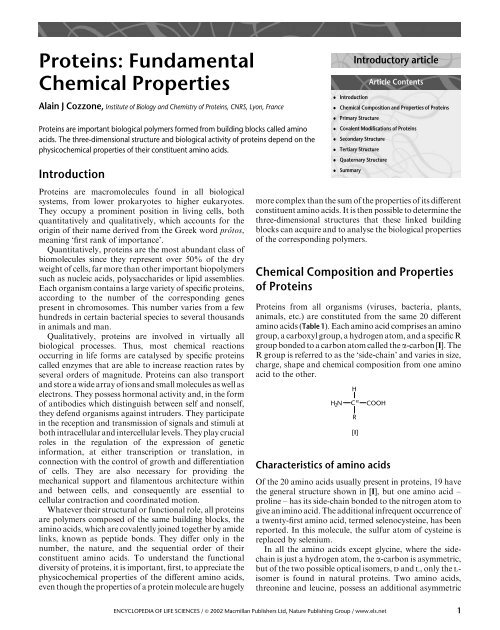

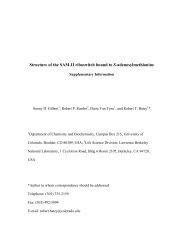

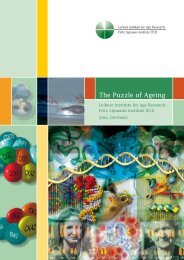

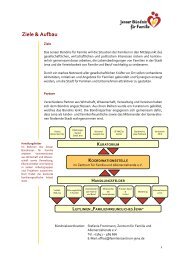


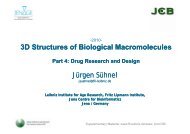
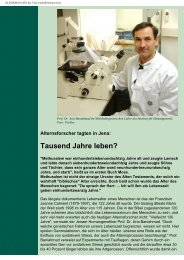

![Programm [pdf]](https://img.yumpu.com/20944039/1/184x260/programm-pdf.jpg?quality=85)
